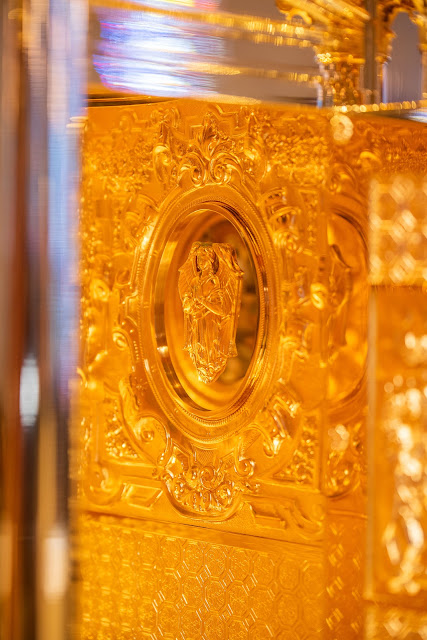 |
| Before and After |
The sanctuary renovation was designed and produced by Granda, with construction work and reinforcement of the building carried out by local architect and parishioner, Thomas Jordan. I had the great honor and joy of participating personally in the development and completion of this landmark project.
The church was originally built in 1967 as a chapel to serve the growing community of Catholic students attending Florida State University, which is located just south of the cathedral. Built on a cruciform plan in a mid-century deco style with Spanish mission influences, the church was consecrated with sparse concessions to decoration or art, with the exception of the large dalle de verre windows by the prolific Jean Barillet.
 |
| Aftermath of the 2019 arson. Thankfully the Tabernacle was unscathed. Tori Schneider / Tallahassee Democrat. |
The easternmost See of the diocese of Pensacola-Tallahassee made the news in June of 2019 due to an arson attack where part of the sanctuary was destroyed by fire and the church suffered extensive smoke damage. It was this destructive event that prompted the rector, Rv. John Cayer, together with a select group of parishioners to embark on a renovation far beyond simply repairing the damage.
Every aspect of this project has been minutely thought out; every detail has intention. The parish committee had a clear vision: they wanted beauty, but not just beauty for its own sake. It needed to have purpose, to serve the liturgy, to catechize, to enrich the life of prayer of the faithful. The configuration of the items in the new sanctuary is carefully tuned to guide the attention of the viewer towards the altar and tabernacle.
The center point of the sanctuary is, of course, the altar, which is built in fine cream and red marble. Its design is purposefully somber so as to not distract from the mysteries that take place upon it. The Christological symbolism is manifest in the colors of the stone, which reference the Body and Blood of Christ, and the bronze medallion of the Agnus Dei set into the central tondo.
Above the altar towers the 36 foot tall reredos, which serves as the visual magnet and narrative instrument for the space. The main body contains three large paintings arranged as continuous scene in the manner of the renaissance sacra conversazione. The mysteries of the Incarnation and the Communion of the Saints are presented in these three panels, with the Child Jesus and the Holy Family flanked on the left side by St Thomas More, Saints Michael and Elizabeth Ann Seton, co-patrons of the diocese and St Augustine, a reference to the See to which this diocese first belonged. The right-hand panel is a window into the history of the first Christian converts, represented as Apalachee family and a Franciscan friar from nearby Mission San Luis.
Forming a vertical axis above the Incarnation and dominating the sanctuary and nave is a sculptural group of the Crucifixion, Christ on the Cross is flanked on either side by Our Lady and St. John, with St. Mary Magdalene weeping at the foot of the Cross. The whole Trinity is present at Calvary, with the Eternal Father and the Holy Spirit represented on the pediment that crowns the altarpiece.
The architectural frame that contains these art pieces echoes the style of 17th century Spanish retablos -- again, a reference to the early evangelization of the region. It is built out of stained cedar wood with details and carvings gilt with burnished 24 carat gold leaf. The design is uniquely tied to the Tallahassee region through the use of local flora, with magnolia blossoms and live oak branches replacing the usual acanthus on the corinthian capitals; the azalea flowers that grow at the foot of Our Lady's throne and the background landscape, reminiscent of the Apalachee forests' pines and oaks strewn with moss.
The gilded tabernacle, in the form of a miniature temple, follows the same classical architectural language as the altarpiece, with Corinthian columns and a dome, surrounded by statuettes of the Four Evangelists. The pediment features a medallion with the pelican in her piety, and the door a relief of the Resurrection. However, hidden to the eye, the interior is richly decorated, in the spirit of Fr. Felix Granda, as a constant catechesis to the priest. The ceiling is formed by a dome enamelled in blue with golden stars, with the Holy Spirit in the center. Opposite the door, framed by garlands, is an oval enamel representing the Last Supper and, on each side, seraphim -- a reference to those that flanked the Holy of Holies and the Seat of Mercy, the presence of God amongst men.
A new baptismal font has also been installed at the foot of the sanctuary steps. Carved out of the same cream marble as the altar, the scalloped bowl recalls the form of a seashell, a symbol of baptism. Around the rim, Jesus’ words to the Samarian woman at the well: “the water I give them will become in them a spring of water welling up to eternal life”
The last element of this great ensemble is the set of monumental Stations of the Cross that hang from the nave walls. The high relief scenes are set in large architectural frames matching the altarpiece, connecting the entire church from the nave to the sanctuary.
 |
| Photographs by David Edscorn / Aperture Horizons Photography, Co-Cathedral of St Thomas More |
































